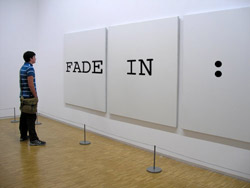Intro
Every few weeks I’ll showcase a modern script that does something really well. The discussion will center on a specific facet of “screenwriting craft.” It won’t be a critique of the full script.
Today’s script is…
The Voices
Genre: Black Comedy / Horror
Premise: A disturbed but well-meaning man attempts to walk the straight-and-narrow while receiving advice from his “talking” pets.
Writer: Michael R. Perry
Details: 111 pages / January 28, 2009 draft
Status: In Development / Black List 2009
Screenwriting craft — What sets this script apart?
SENSORY IMAGERY
What is Sensory Imagery? Here’s a pretty good definition:
Sensory Imagery is a writing technique based on the five senses. Using [words] to describe what is seen, heard, felt, smelled, and tasted draws the reader into the story… [T]his technique helps the reader to feel transported into the place where the story takes place by helping the reader to feel, hear, see, smell what the main character [experiences].1
Basically, the more you can evoke a reader’s five senses, the more immersive and vivid your script will feel.
Sights and sounds are obviously script mainstays (“Only what you can see and hear”). But what about the other three senses? If you’re a skilled writer like Michael R. Perry, you can also strategically evoke (or suggest) touch, taste and smell.
In this example, the protagonist Jerry, returns to the spot where a woman (Katie) has been killed. (WARNING: Graphic imagery):
EXT. WOODS – TWILIGHT
Long shadows and a light rain makes the woods look radically different from the last time Jerry was here. He carefully makes his way down the edge of the ravine, and then stumbles on something. He looks down.
Katie’s hand sticks out from under a pile of leaves. It’s discolored and swollen except her manicure, which is perfect.
He brushes leaves off of her; she’s been outside nearly three days and is swollen, gooey and stinky. Further, some woods animal has started eating her stomach, none too neatly. Jerry tries to lift up her body but gets slimed with bowel oozing, is repulsed, and drops her.
Keep In Mind
- Enhanced sensory details like taste and smell in a script are used primarily to indicate a character’s reaction to something — hence, to show what’s happening. For example, you wouldn’t describe the aroma of a hot cup of coffee if a character isn’t savoring the experience.
- Don’t get carried away with your scene descriptions. A little goes a long way. Only utilize sensory imagery that’s essential to a reader’s comprehension of what’s going on, or to reinforce tone. You’re writing a script, not a novel, after all.
Do you utilize all five senses in your screenwriting when appropriate?
Further Reading
Need someone to review your screenplay and give you insights that are guaranteed to make it better? Please take a look at my script services.






Very cool. You don’t hear too much about this out there.
Great to hear Scott, thanks. My goal for this blog is to discuss things that you don’t normally see on the other blogs.